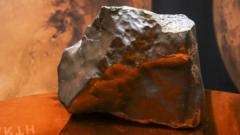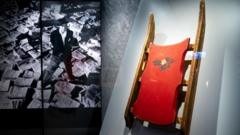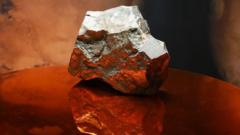**The recent auction of a Martian meteorite from Niger has raised significant concern regarding the legality of its sale and the implications for cultural heritage, prompting a government inquiry.**
**Mars Meteorite Auction Sparks Controversy Over Ownership and Heritage**

**Mars Meteorite Auction Sparks Controversy Over Ownership and Heritage**
**Niger's Government Investigates Legality of $4.3 Million Sale of Rare Martian Meteorite**
In an extraordinary turn of events, a Martian meteorite discovered in the Sahara Desert of Niger has ignited a firestorm of controversy following its recent auction at Sotheby's in New York, fetching an impressive $4.3 million. The sale of the largest Martian rock ever found has prompted members of the Niger government and advocates for cultural heritage to question the legality of its export and the fate of the proceeds from the sale.
Prof. Paul Sereno, a prominent palaeontologist with close ties to Niger, expressed his frustration over the meteorite, labeled NWA 16788 (Northwest Africa 16788), being sold without consideration for its country of origin. He argues that such a significant piece of extraterrestrial material should remain in Niger, where it can be appreciated and studied.
The auction drew considerable attention as less than 400 meteorites out of over 50,000 found have been identified as originating from Mars. However, following the initial excitement, questions arose about how this meteorite made its way to an auction block on the other side of the globe. Niger’s government is particularly concerned about potential illicit trafficking, pushing for an investigation to determine how the meteorite escaped their borders and whether local laws were violated.
According to reports, NWA 16788 was reportedly discovered in November 2023 by an unnamed meteorite hunter and subsequently sold to an international dealer, which then facilitated its global journey. Sotheby's has maintained that all necessary legal procedures were adhered to at every step of this meteorite's transition from Niger to Italy and ultimately to New York.
In Niger, however, the situation remains fraught with complexity. The government acknowledges that while there is no specific legislation governing the export of meteorites, broader laws regarding national heritage protection may have been transgressed. The 1997 law designed to conserve Niger's cultural and natural heritage includes categories for various artefacts but does not explicitly mention meteorites.
As discussions about meteorite ownership continue, the plight of Niger's celestial treasure draws parallels to Nigeria's neighbor, Morocco, which has faced similar challenges in regulating meteorite exports, despite its own rich trove of extraterrestrial finds. In a culture where the identity and heritage tied to these celestial bodies are increasingly recognized, advocates like Prof. Sereno hope that the sale of NWA 16788 will motivate Nigerien officials to implement measures to protect their mineralogical heritage.
Experts reflect on the need for comprehensive regulations that address not just meteorites but a range of items deemed of historical and cultural significance. With meteorites being a part of the tapestry of global interest in both science and culture, the outcome of this case may set a significant precedent for how countries globally manage their extraterrestrial resources.
Prof. Paul Sereno, a prominent palaeontologist with close ties to Niger, expressed his frustration over the meteorite, labeled NWA 16788 (Northwest Africa 16788), being sold without consideration for its country of origin. He argues that such a significant piece of extraterrestrial material should remain in Niger, where it can be appreciated and studied.
The auction drew considerable attention as less than 400 meteorites out of over 50,000 found have been identified as originating from Mars. However, following the initial excitement, questions arose about how this meteorite made its way to an auction block on the other side of the globe. Niger’s government is particularly concerned about potential illicit trafficking, pushing for an investigation to determine how the meteorite escaped their borders and whether local laws were violated.
According to reports, NWA 16788 was reportedly discovered in November 2023 by an unnamed meteorite hunter and subsequently sold to an international dealer, which then facilitated its global journey. Sotheby's has maintained that all necessary legal procedures were adhered to at every step of this meteorite's transition from Niger to Italy and ultimately to New York.
In Niger, however, the situation remains fraught with complexity. The government acknowledges that while there is no specific legislation governing the export of meteorites, broader laws regarding national heritage protection may have been transgressed. The 1997 law designed to conserve Niger's cultural and natural heritage includes categories for various artefacts but does not explicitly mention meteorites.
As discussions about meteorite ownership continue, the plight of Niger's celestial treasure draws parallels to Nigeria's neighbor, Morocco, which has faced similar challenges in regulating meteorite exports, despite its own rich trove of extraterrestrial finds. In a culture where the identity and heritage tied to these celestial bodies are increasingly recognized, advocates like Prof. Sereno hope that the sale of NWA 16788 will motivate Nigerien officials to implement measures to protect their mineralogical heritage.
Experts reflect on the need for comprehensive regulations that address not just meteorites but a range of items deemed of historical and cultural significance. With meteorites being a part of the tapestry of global interest in both science and culture, the outcome of this case may set a significant precedent for how countries globally manage their extraterrestrial resources.















